Getting Your Dog Used to Being Groomed
Zookeepers are well aware of the value of husbandry training for their animals. Animals in zoos often need to be weighed, have blood drawn, get their nails clipped, and various other maintenance activities. Gone are the days when animals are anesthetized or pressed into squeeze cages for this work. Now trainers teach the animals to stand quietly while their bodies are handled or medicated. Elephants open their mouths to have their teeth inspected, giraffes stand still on a weigh scale, and dolphins swim up and hold out their fins to have blood taken. How do trainers accomplish this? It’s actually quite simple. The animal is taught to climb on the weigh scale or present its ear for the reward of a treat. The behavior is well established without exposing the animal to any unpleasant experiences. An impressive example is the story of a diabetic baboon living in a California zoo. The baboon needed daily insulin shots but he was so aggressive, he had to be sedated each time. This was taking a toll on his health, because of both the sedative and the chronic stress. The zoo brought in animal trainer Gary Priest to see what could be accomplished. Progressing in very small steps, Gary was able to teach the baboon to extend his arm through the bars of the cage and grasp a bar while a technician applied alcohol to his arm, presented a needle, and applied a quick pinch. Eventually, the baboon was happy to go through the whole routine for his favorite reward. Several times a day, the procedure was repeated and, once a day, the baboon was given his insulin. To ensure the baboon’s continued cooperation, the number of mock injections had to be much greater than the number of real injections.
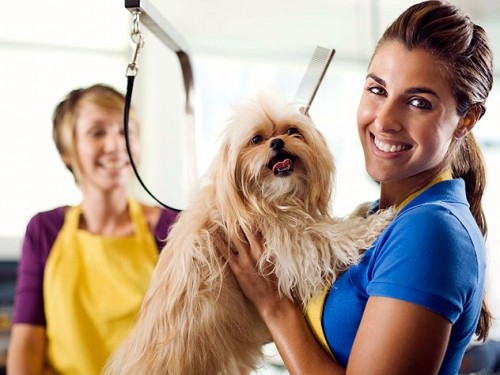
Two or three times a day, play “air” nail clipping. Have your puppy or dog sit and stay. Lift one paw and pretend to clip all the nails but just clip air! Do the same with all four feet. Once a day, clip ONE nail (only if they need it). Intersperse treats throughout. If you do this religiously, your dog will be well mannered and calm during nail clipping. Now, I don’t continue to do this throughout my dog’s life. Once you’ve established a solid foundation, your dog will only need occasional practice.
If your dog is already averse to nail clipping, you’ll have to break the procedure down to miniscule steps. You may have to start by just holding your dog’s paw and touching each nail, with the nail clippers sitting on a nearby table. Treat frequently. Once the dog is comfortable with this, hold the nail clippers in one hand, while holding the dog’s paw with the other. Next, “air clip” only one nail, give an amazing treat, and quit. Resist progressing until the dog is completely comfortable with the step you’re working on. Again, it’s advisable to do this when the dog is sleepy so you’ll meet with less resistance. Be patient – it can take months to reform an intractable nail “clippee”. If all else fails, trot your dog on pavement every day and your nail clipping activities will be restricted to his dewclaws!
Every dog is likely to need medication at some point in his life.
It’s a good idea to accustom your puppy to having his mouth handled so that you can give pills or liquid medicine. For this, I recommend the “baby bird” routine. You’ve probably seen how a baby bird opens its mouth wide to receive a meal from its parent. The baby trusts that food will end up in its mouth. You can teach your puppy to also expect a prize when you open his mouth. Hold the puppy in your lap and place one hand over the top of the puppy’s muzzle. Pry his jaw wide open. With the other hand, pull his bottom jaw down and place a tasty treat on his tongue. Release his mouth. He’ll immediately discover and eat the treat. Make sure you don’t place the treat so far back that the puppy might choke. Repeat numerous times. Pretty soon your puppy will welcome you handling his mouth and, if you occasionally stick a pill inside the treat, your puppy will be unlikely to notice. You may not ever need this training to successfully administer pills but it sure is handy if you have to give liquid medicine or poke around in there to retrieve a chicken bone.
Is there a better way to give pills? Dogs that love food are pretty easy to give pills – just hide the pill in a piece of cheese or wiener and the chowhound is happy to take his medicine. More discriminating dogs chew their food, detect the unwanted pill, and leave it lying on the kitchen floor. For these pill-savvy dogs, here’s a trick that often works. Teach the dog to catch treats tossed to him. Most dogs don’t bother to chew if you get them expecting to catch treats one after the other. On pill days, toss a series of yummy treats, with the pill hidden amongst them. Your dog will never suspect!
Be proactive with your dog. Teach him to enjoy all the things that will inevitably happen to him. He’ll be handled by groomers, poked and prodded by technicians, given needles by veterinarians. You’ll need to check his teeth, inspect his ears and eyes, clip his nails, and give him medication. None of these experiences are naturally pleasant for the dog so teach him to enjoy them. Your dog will be so much easier to care for if you do the foundation work.
How to Trim a Dog’s Nails
When you think about grooming a dog, you probably consider bathing him, brushing his coat, even cleaning those floppy ears, but its a good idea to give dogs a pedicure every few weeks as well. If youve never trimmed a dogs nails, ask for some help from a more experienced person, and keep these instructions nearby.
1: Stay Sharp
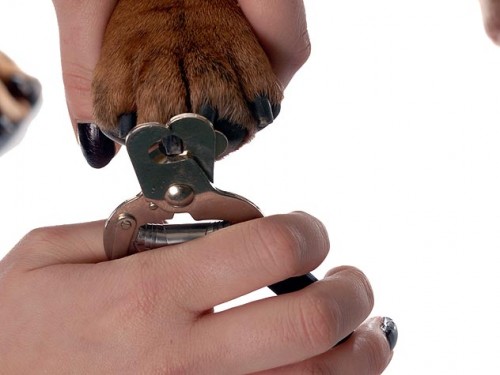
2: Pull Their Legs
Dogs are often pretty cooperative when it comes to having their nails trimmed, and those who were handled often as puppies are even more likely to comply. Still, you may need to work a little to keep the animal still. If youre working alone, have the dog sit or lie down on the floor or examining table, then trim the nails, one paw at a time.
3: Pull Their Legs, Part II
If youre grooming a larger dog or if the animal is apprehensive, have someone sit him down and hold out his paw, then get to work with the clippers. Have your helper scratch behind the dogs ears to reassure the animal and help move things along a little more quickly.
4: Take the Edge Off
Remember that you should only remove the very end of the dogs nails. You may be tempted to trim off all of the excess, but that would be a mistake. In dogs, the quickthe nerve endings and blood vessels inside the nailcontinue to grow as the nail grows. That means long nails must be trimmed bit by bit, over weeks or months, until the quick gradually recedes. Because its so difficult to see the quick in dogs with dark nails, youll need to look at the nail straight on (see diagram below)and keep trimming until you see a small dark circle. If you accidentally clip too far and the nail begins to bleed, apply pressure to the tip of the nail or dip the nail in a bit of styptic powder, then make sure the animal is kept inactive for a short time.
5: Thank Them Very Much
Give the dog a treat or a pat on the tummy to thank him for his cooperation, and things should go at least as well the next time around.
Professional Dental Cleanings
Just as important as providing your pet with food, water and regular physical exams is an annual, professional dental cleaning. Even with good regular at-home care, plaque and tartar build up, making professional cleanings essential. Untreated dental disease can cause significant discomfort and pain as well as permanent loss of teeth and gum tissue. Remember, your pet cannot tell you when he or she is in pain. Pets rely on their owners to take care of them and recognize when something is out of the ordinary.
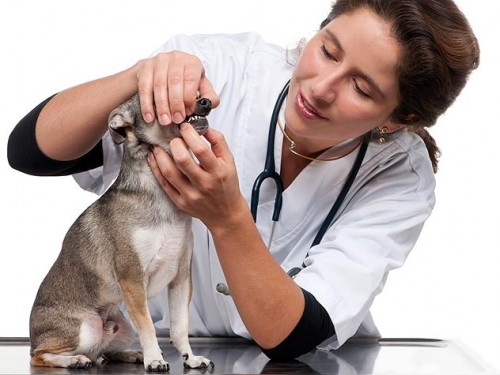
Your veterinarian will run pre-operative bloodwork to make sure your pet is healthy enough to undergo the anesthesia necessary for the procedure. While modern anesthesia is considered very safe, this is a precautionary measure to minimize any risks.
Your veterinarian might take dental radiographs (X-rays) to provide a better evaluation of the health of your pet’s teeth and jaw bone.
During the cleaning, the veterinary team will monitor your pet’s vital signs to ensure that they are normal. These vitals include respiration rate, heart rate, blood oxygen levels and body temperature.
Your pet’s teeth will be cleaned and polished with professional equipment that smoothes the tooth surface, removes tartar and plaque and polishes the teeth.
Antibitoics and/or pain medications may be prescribed depending on the extent of disease at the time of cleaning.
Once the dental cleaning is complete, your pet will be carefully brought out of anesthesia. Your veterinarian will ensure that your pet has recovered properly before releasing him or her to go home. Follow all home care instructions and be sure to check with your veterinarian immediately if you have any concerns.
How To Bathe a Dog: More Tips
Even though a good bath is one of the kindest things you can give your shelter’s dogs, chances are they’re not going to see it that way. But while you probably won’t win the hearts of all canines by getting them wet, you can make the experience more pleasant for both you and the dogs if you follow these steps. These instructions are appropriate for friendly shelter dogs in need of just a bit of cleaning. Heavily matted or aggressive dogs should be handled by a professional groomer.
1. Put on Your Wet Suit
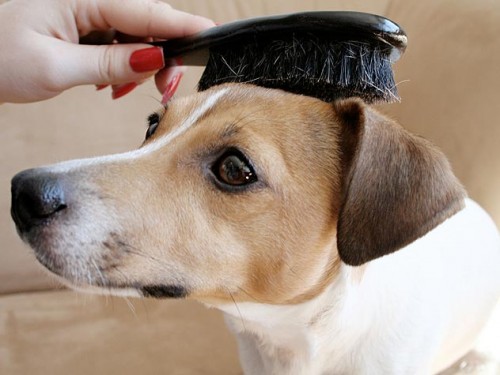
2. Prepare the Pooch
Before starting the bath, you may want to let the dog get accustomed to you, and give her a chance to relieve herself. If the animal is particularly nervous, consider muzzling her and asking a partner to help you. Try to comb out major snarls in the dog’s fur, and trim her nails to keep her from clawing you accidentally. Put a drop of mineral oil in each of the dog’s eyes and cotton balls in her ears to keep water and soap from getting in them. Be sure to remove the cotton balls after the bath!
3. Lather, Rinse, Repeat
If the dog is heavy, don a back brace. Then lift the dog into the tub. Use a lightweight spray hose that can be maneuvered with one hand. Test the water temperature before spraying the dog, then gently get the dog used to the temperature by spraying water on her back and shoulders. After the dog relaxes, begin washing her head and then move gradually toward her rear; this will prevent fleas from moving up her body and congregating on her head and face. Lather the animal with a mild shampoo formulated for dogs. The active ingredient should be chlorhexidine, which is mildly antiseptic. If you must use an insecticide, use a gentle pyrethrin-based shampoo, and be sure to follow the safety instructions on the bottle. Oatmeal shampoos are good for dogs with itchy skin.
4. Make Fluffy Fluffy
Scrub and rinse the dog thoroughly. Soap stays in the fur long after it seems to be gone, so keep rinsing. When you finish, rub the dog down thoroughly with towels. Don’t put a wet dog back in her cageit’s okay if she’s just damp, especially if you have a climate-controlled facility. If you use an automated dryer that hangs on the front of the cage, test the temperature of the air before aiming it toward the dog, and check on the animal at least every 15 minutes or so to make sure she’s comfortable.
5. Suds Up the Puppies
Puppies have special bathing needs. Don’t use an insecticidal shampoo on a puppy unless the shampoo is formulated specifically for puppies and the puppy actually has fleas. With a young dog, it’s especially important to use warm water and make his bathing experience pleasant, using just the right combination of gentleness and firmness. If you are kind and sensitive to their fears, puppies will begin to regard their baths with pleasure rather than dread, making life more pleasant for you, for the puppies, and eventually for their adoptive families.
Dog Anal Gland Care
You know all that doggy butt-sniffing that we humans seem to find either appalling or hilarious? Ever ask yourself what that’s all about?

Healthy anal glands express, or empty, this fluid when the dog has a bowel movement. Unfortunately, some anal glands don’t work as they should because of inherited malformations, or because of a history of poor-quality foods that produce poor-quality bowel movements.
If the anal glands don’t empty properly, they can become impacted, making bowel movements difficult or painful, and potentially leading to infections or abscesses.
It’s not uncommon for a rescued dog to have a history of anal gland problems. Your dog may damage the delicate tissue around his anus in his attempts to relieve his own discomfort, so if you see him biting at his butt, or scooting it along the ground, take him to the vet.
Impacted anal glands can often be relieved by manually expressing, or squeezing out, the fluid they contain. This is a very smelly process, but if you’re game you can have your vet or groomer teach you how to do it. Most people whose dogs need their anal glands expressed periodically prefer to pay to have it done.
If your dog’s anal glands get impacted frequently, ask your vet to recommend a high-fiber diet to create bulkier stools. If that doesn’t work, and if your dog has repeated infections or abscesses from impaction, the anal glands may need to be removed.
At-Home Dental Care for Your Pet
Many pet owners dismiss their pets’ bad breath as simply “normal” or something to be ignored. However, bad breath is a hallmark of periodontal disease, a bacterial infection of the gums and supporting structures of the teeth. If you notice that your pet’s mouth has an odor and/or you observe discolored teeth, he or she may have developed some degree of periodontal disease. What starts as gingivitis (inflammation of the gums) can quickly lead to permanent loss of gum tissue, damage to ligaments and loose or missing teeth. Periodontal disease can cause bacteria from the mouth to enter the pet’s bloodstream and circulate through the heart, liver and kidneys.
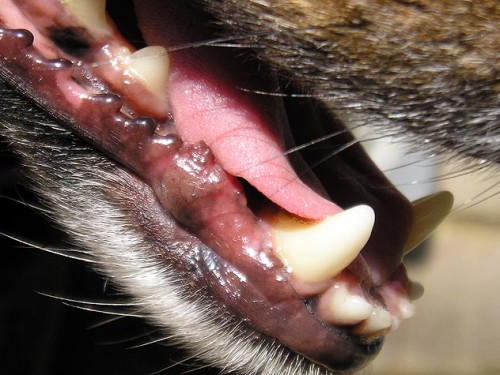
At-home care can include the use of water additives, tooth brushing with specially-formulated toothpaste for pets, dental chew toys, kibble designed to clear and prevent the build-up of plaque and paying special attention to any changes your pet exhibits. As a pet owner, you should examine your pet’s mouth at least once a week to look for signs of swollen or bleeding gums (gingivitis), brown buildup on teeth (plaque/tartar) and abnormal lumps, bumps or swellings. Be sure to examine the back teeth (molars) by lifting the lip to expose the outside surfaces of the teeth. Also, observe the color of your pet’s gums. The gums should be shiny and pink — not white or dark red.
If you notice any usual signs or symptoms or changes in your pet’s mouth, consult your veterinarian to schedule an exam. He or she will examine your pet, inform you of any problem areas and make treatment recommendations. You might need to schedule a professional dental cleaning, according to your veterinarian’s recommendations for your pet’s particular breed and condition.
How to Give Your Dog a Bath
As much as we all love for our furry friends to smell fresh and clean, getting to that point isn’t always easy. Dogs are rarely excited to jump into the bathtub for a good scrub. Bathing fearful dogs might be better handled by a professional groomer or your veterinary office. But if you decide to wade in, here are some helpful hints.
GETTING (YOU) READY
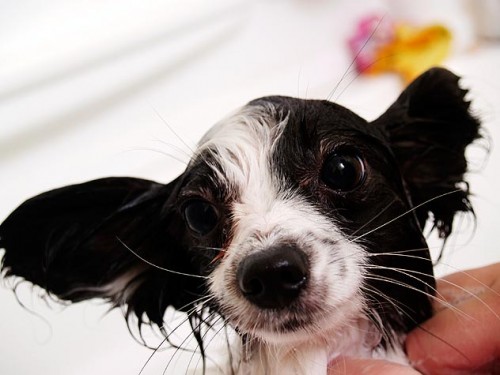
GETTING (FIDO) READY
Trimming your pet’s nails prior to bath time will not only give your dog better footing, it will also help protect your skin in case he tries to make a break for it. Now, bring the dog into the bathroom and close the door behind you catching a wet, soapy dog running down your hallway is no easy task! Give praise and treats to make him comfortable in the bathroom before you try to get him into the tub. If you’re able to, gently putting a cotton ball in each ear can help keep water out — just be sure to remove them when you’re finished! Also, to help keep shampoo from irritating his eyes, you can put a drop of mineral oil in each one.
BRING ON THE SUDS
Dogs are unlikely to get into the tub willingly. For bigger dogs, a second person to help you get Fido into the bath can help avoid straining your back. Make sure water isn’t too hot or too cold. Let your dog hear and then gently feel the water before going full-speed ahead with the bath. Start shampooing your dog’s shoulders and then move out from there. Be gentle around the face and any sensitive areas but be sure you get down to the undercoat. Read the directions on the shampoo bottle carefully to ensure proper usage. Rinse out all the shampoo, using your fingers to make sure you get through the undercoat to avoid subsequent irritation. This is where a detachable showerhead or bowl comes in handy to be sure bigger dogs get rinsed thoroughly.
NO MORE TANGLES
After the shampoo has been completely rinsed out, you can apply conditioner, if desired. Follow the directions on the bottle because some products need to sit on the coat for several minutes. If you have a particularly squirmy dog, you’ll want to find a fast-acting formula. Once you have finished the bath, it is time to dry your pooch. Towel dry as much as possible in the bathroom. For dogs with longer coats, you may want to use a blow dryer set on low. Before the dog leaves the bathroom, brush his coat out thoroughly because the bath will loosen up a lot of fur, which is better contained in the bathroom than all over the house. Many dogs get “after-bath-crazies,” so hold onto your hat and let ‘em run!





